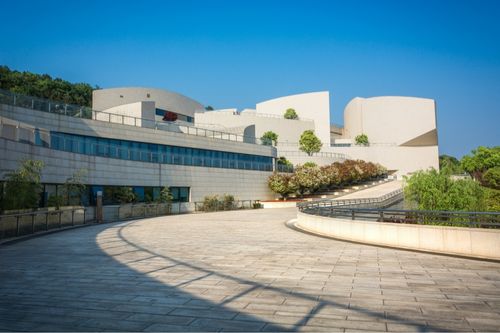Table of Contents
Bauhaus University | Introduction
Bauhaus University, founded in Weimar, Germany was a revolutionary institution that has left an indelible mark on the fields of design and art. The university’s founders, Walter Gropius, László Moholy-Nagy, and Johannes Itten, envisioned a radical new approach to art education. The institute would unite fine arts, crafts, and technology to create a new aesthetic for the modern era.
Bauhaus University | Origins
The Bauhaus School, as it was originally called, quickly became a center of avant-garde thought and experimentation in art, architecture, and design. The school attracted some of the most innovative artists and designers of the time, including Paul Klee, Wassily Kandinsky, and Marcel Breuer, who would go on to become key figures in the development of the modernist design.
In 1925, the school moved to a purpose-built campus in Dessau, where it continued to flourish under Gropius’s leadership. In 1932, however, the Nazi regime forced the school to close, and many of its faculty and students were forced to flee Germany. Despite this setback, the legacy of the Bauhaus School lived on, and in 1996, the institution was reborn as the University, continuing the mission of its founders to explore the intersections between art, technology, and society.
Bauhaus University | Curriculums and programs

The curriculum and programs offered at the University reflect the school’s continued commitment to interdisciplinary experimentation and innovation. The university offers a range of programs in the fields of art, design, architecture, and media, with a focus on creative problem-solving, experimentation, and collaboration.
One of the unique features of the curriculum at the University is its emphasis on project-based learning. Students are encouraged to work on real-world design challenges in collaboration with industry partners, government agencies, and community organizations. This approach not only gives students practical experience but also helps to build relationships between the university and the wider community.
Examples of programs and courses offered at University include the Master of Fine Arts program in Public Art and New Artistic Strategies, which focuses on the intersections between art, politics, and social change; the Bachelor of Fine Arts program in Visual Communication, which explores the ways in which design can be used to communicate ideas and emotions; and the Master of Science program in Integrated Design, which combines design thinking with sustainability and social responsibility.
Faculty and staff of university
The faculty and staff at the University are among the most innovative and respected in their fields. Many have extensive professional experience working in industry or government, and all are committed to helping students develop their creative and critical thinking skills.
Key faculty members at Bauhaus University include Susanne Hauser, a professor of product design who has worked on projects ranging from furniture design to urban planning; Olafur Eliasson, a world-renowned artist and designer whose work explores the intersections between art, science, and technology; and Ines Lindner, a professor of media theory and history who has published extensively on the social and cultural impact of new media technologies.
In addition to their teaching and research activities, Bauhaus University faculty and staff also engage in collaborative projects with industry professionals and government agencies. For example, the university’s Digital Bauhaus Lab is a research and innovation center that works on projects ranging from 3D printing to virtual reality, in collaboration with industry partners such as BMW and Siemens.
Bauhaus University | Campus life and facilities

Bauhaus University’s campus, located in the city of Weimar, is itself an example of innovative design and architecture. The campus is home to a range of state-of-the-art facilities, including design studios, workshops, and research labs, as well as a library and student housing.
The campus community at Bauhaus University is vibrant and diverse, with students and faculty from around the world. The university offers a range of extracurricular activities in sports, music, and other cultural pursuits, as well as a variety of student organizations and clubs that cater to a wide range of interests.
One of the most important aspects of the campus community at Bauhaus University is the emphasis on collaboration and interdisciplinary learning. Students are encouraged to work across disciplines and engage with different perspectives, which fosters a rich and diverse intellectual environment.
Alumni and success stories
In addition to the campus community, Bauhaus University also has a strong network of alumni who are working in a variety of fields around the world. Many Bauhaus alumni have gone on to become leaders in their respective fields, from architecture and design to film and media.
The legacy of the Bauhaus School is still alive today, not only in the work of its alumni but also in the broader cultural landscape. The Bauhaus School’s commitment to innovation, experimentation, and interdisciplinary collaboration continues to inspire artists, designers, and thinkers around the world.
Bauhaus University | Future
As Bauhaus University approaches its 100th anniversary, it is clear that the institution remains at the forefront of art, design, and technology. The university’s commitment to creative problem-solving, collaboration, and social responsibility prepares its graduates to tackle the complex challenges of the modern world.
Key takeaways
- In conclusion, Bauhaus University is a unique and innovative institution that has had a profound impact on the fields of art, design, and architecture.
- Its commitment to interdisciplinary collaboration and experimentation has helped to shape the cultural landscape of the modern era.
- With a vibrant campus community, a diverse and distinguished faculty, and a commitment to creative problem-solving and social responsibility, Bauhaus University continues to be a leader in the field of art and design education.
Did you find this blog helpful? Do share your perspectives about the blog in the comments below. Please get in touch with us by clicking here for more information about Bauhaus University. We would be happy to assist you with your queries.
Liked this blog? Read next: Royal Military College of Canada | Programs and campus life
FAQs
1. What programs does Bauhaus University offer?
Answer: Bauhaus University offers a range of programs in the fields of art, design, architecture, and media. These include bachelor’s and master’s degree programs in fields such as Visual Communication, Product Design, Integrated Design, and Public Art and New Artistic Strategies, among others.
2. What is the teaching approach at Bauhaus University?
Answer: Bauhaus University emphasizes project-based learning and collaboration, giving students practical experience working on real-world design challenges in collaboration with industry partners, government agencies, and community organizations. The university also encourages interdisciplinary learning and engagement with different perspectives.
3. What is the campus community like at Bauhaus University?
Answer: The campus community at Bauhaus University is vibrant and diverse, with students and faculty from around the world. The university offers a range of extracurricular activities in sports, music, and other cultural pursuits, as well as a variety of student organizations and clubs that cater to a wide range of interests. The emphasis on collaboration and interdisciplinary learning fosters a rich and diverse intellectual environment.






